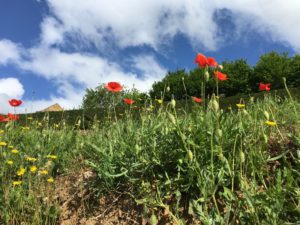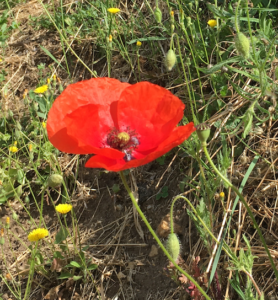 We left the village, biking on the path that led into the French countryside. Speaking only a little of the language, we were unsure what we were going to see on this afternoon adventure. We bumped along the cobblestones through another quaint and ancient village and drifted along beside a bubbling, clear stream and passed by acres of walnut orchards but it wasn’t until we came to the open fields beyond that the most spectacular scenery of the ride came into view. There, we saw field after field of blood red poppies, so startlingly beautiful that we had to stop and take it in.
We left the village, biking on the path that led into the French countryside. Speaking only a little of the language, we were unsure what we were going to see on this afternoon adventure. We bumped along the cobblestones through another quaint and ancient village and drifted along beside a bubbling, clear stream and passed by acres of walnut orchards but it wasn’t until we came to the open fields beyond that the most spectacular scenery of the ride came into view. There, we saw field after field of blood red poppies, so startlingly beautiful that we had to stop and take it in.
I had heard about the poppies in France, of course, because of John McCrae, a Canadian veteran who immortalized poppies in his poem, “In Flanders Field.” According to the story, during World War I, the fields in Flanders (actually an old name given to the region that spans the border between southern Belgium and northwestern France) were trampled and lay fallow. Poppy seeds lay dormant but still viable and when peace was restored, the fields burst into bloom and the red poppy became the symbol of all those who died in the war. In 1921, England celebrated “Poppy Day” and thousands of paper poppies were made and sold to support families of war veterans.
There is no doubt that poppies can grow in great profusion. Actual soil counts show that as many as 2,500 poppy seeds can be found in a single square foot. This bright red European wildflower is called a “corn” or “Shirley” poppy and is not a source of opium.
We were, in part, fascinated with the poppies because this is not a plant that grows wild in North America. We have several different kinds of poppies, but they are all cultivated as garden plants. Our only wild poppy is the bright orange California poppy, in the same family but a different genus.
The Oriental Poppies, which is where opium comes from, are some of the most beautiful of the garden poppies. With blossoms as much as 12 inches across, they can make a stunning display. These do best in cool climates with low humidity (i.e. not Georgia) and need to be placed in full sun. Seeds sown in late spring will provide late summer or early fall blooms.
